
Create your Own Organic Garden
We all like to be surrounded by greenery at home. Plants fill our environment with aromas and colour, and improve its quality. They ‘re very grateful beings: the more you look after them, the better they’ll grow and the more colourful they’ll be. Besides, from time to time, many of them will give you gifts as flowers, fruits and vegetables. Creating an urban garden can be a good way to spend time with your family and teach young children about care, consistency and collaborative work. But it’s a lot more than that. It’s also a great responsibility.
When you take care of a garden, you have to take the rough with the smooth because plant gratitude also acts in the opposite direction: if you spend time without taking care about them, they won’t survive. They depend on you, but it’s not always easy to know what they need: each plant and season of the year is a world apart. Your protection work also includes getting rid of diseases and parasites, and keeping an eye on how your plants respond to each situation. Don’t be alarmed, the results are worth it, and we’ve prepared a guide full of tips and guidelines for getting a healthy and sustainable urban garden. Fancy it?
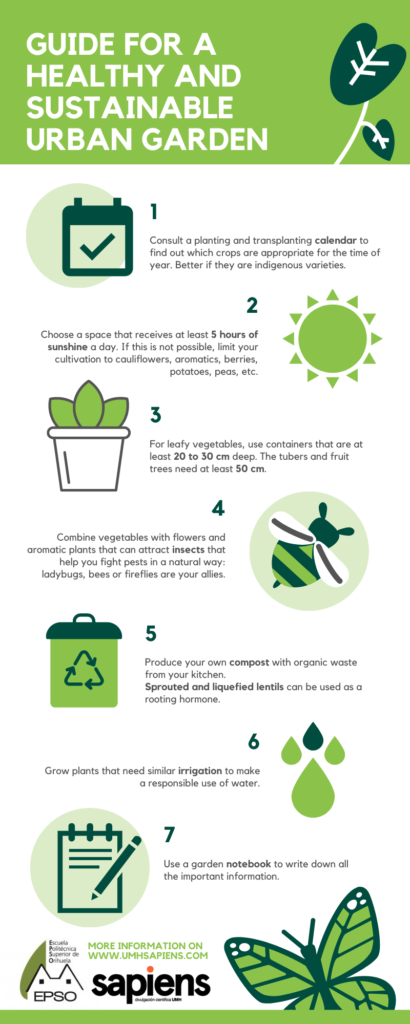
Guide for a Healthy and Sustainable Urban Garden
The first thing to keep in mind before preparing anything is to check a planting and transplantation calendar to find out which crops are appropriate for each time of the year. It’s better to choose native varieties, that is, from your area. That way you are sure beforehand that they’re already used to your climate and other environmental conditions.
Grow plants that need similar amounts of water together: in this way, making mistakes will be more difficult and we ‘ll water them in a more responsible way.
It may seem a lot, but, in fact, routine and consistency are enough to keep you up to date. You can use your personal garden notebook to point out all the important facts, plant development and tips like the ones you’ve just read.
Autumn-winter plantings
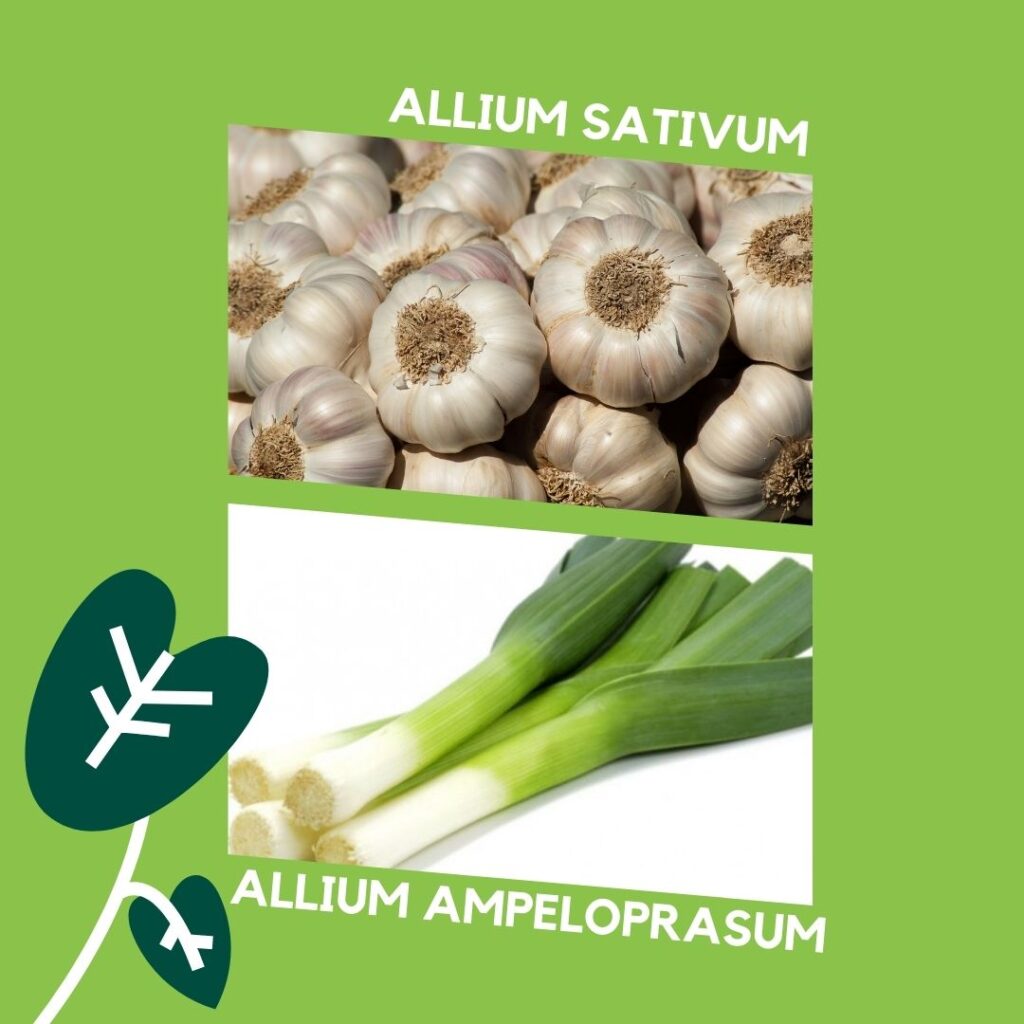
Low-irrigation crops
Garlic and leeks (separated from 15 to 25 cm or sown in different pots).
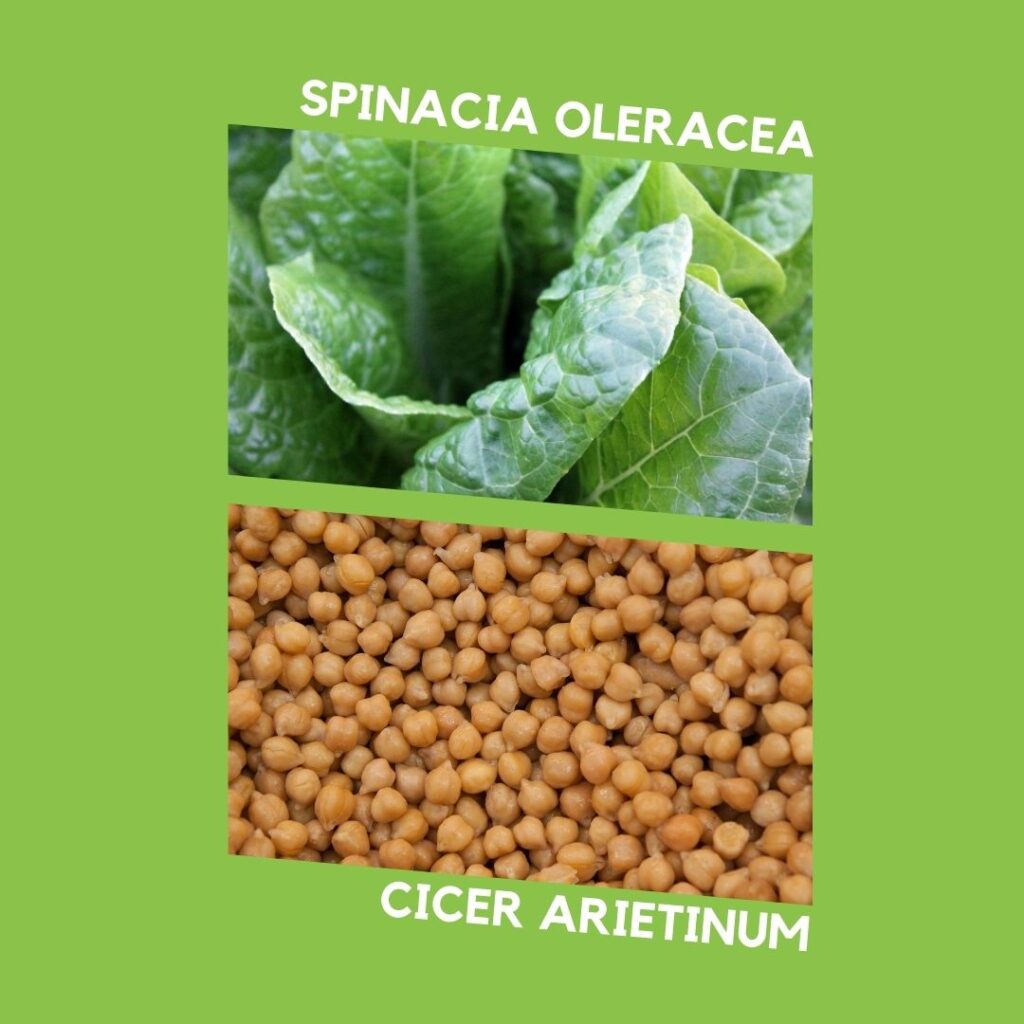
Mid-irrigation crops
Broccoli, cauliflower, spinach or peas (separated by 15 cm); eggplant, zucchini and green beans (separated by 20 cm); also onion and chickpie.
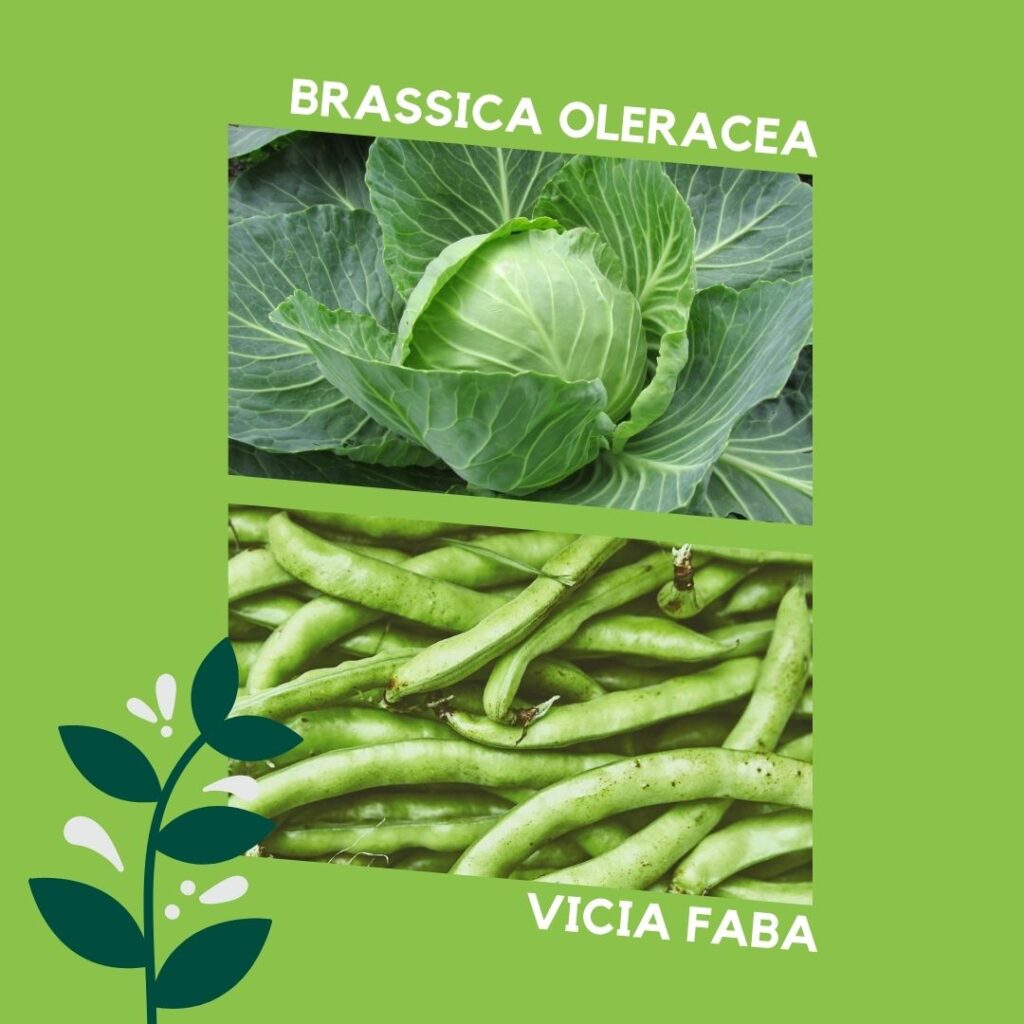
High-irrigation crops
Cabbage and broad beans (separated from 15 to 20 cm or sown in different pots).
Once you have selected your favourite crops, you’ll have to think a place for the garden. The best place will be the one where the plants can get at least five hours of sun each day to get enough energy. If there is no such place in your house, you can also plant cauliflowers, aromatic plants, berries, potatoes or peas, which are less demanding.
There are different types of vegetables, each requiring a different container. Leafy vegetables, such as chard, cabbage, spinach, lettuce, lamb’s lettuce, endives… are the ones we eat from the leaves. In the case of tubers, they are eaten from the roots. This is the sweet potatoes, onions, turnips, potatoes, radishes, beets or carrots’s case. Finally, from fruit vegetables, as you may have already guessed, the fruit they produce is what we eat: aubergines, zucchini, pumpkins, strawberries, peas, broad beans, beans, cucumbers, tomatoes…
For leafy vegetables, we will use containers (pots or whatever you prefer, as long as it is suitable for growing) at least 20-30 cm deep. In the case of tuber and fruit trees, they will need at least 50 cm.
Combine vegetables with flowers and aromatic plants. In addition to giving life and color, they will attract good insects for them, which will help fight pests naturally. Ladybugs, bees or fireflies are your allies, their visits will indicate health in your garden.
You will also need fertilizer. It is recommended to make your own compost, an ecological alternative to commercial products that you can create by mixing the organic waste that is at home, such as fruit and vegetable skins, old flowers, remains of cut grass… Sprouted and liquefied lentils can be used as a hormone for plants to grow better.
It may seem like a lot, but routine and perseverance are the keys to bring everything up to date. You can use your personal garden notebook to write down all the important data, how the plants are growing and tips like the ones you just read.
Treatment and prevention of pests and fungi: organic and home care
The first step to keep pests or fungi away from our garden is prevention. Protect your garden by ensuring that the soil isn’t too wet and that it’s in a well-ventilated area. Take a look at your plants: look at their leaves on both sides to find if they have parasites or strange things.
To kill greenfly pests on your plants, clean them carefully with a 3 % solution of potassium soap in hot water. (This type of soap can be bought in most supermarkets but, watch out! Warm up the water only to dissolve the soap. The water should be at room temperature when watering the plant.) Another “potion” for your plants’ health is a maceration of chopped garlic, water and oil. It eliminates fungi and prevents the appearance of whiteflies, greenflies and mites, like the red spider mite. These substances shouldn’t be left in the plant for a long time, it’s good to let them on the plants for two hours and then rinse them with water to avoid damage. Repeat the process once or twice a week.
Another way to avoid ‘bad’ insects in your garden is creating traps for them, using yellow chromatic traps (a bright yellow sheet to attract their attention, covered with adhesive to trap them) or a heavy-coloured plastic painted with oil. This will prevent the proliferation of flying bugs — such as the whitefly — laying eggs on the leaves. The red spider mite’s tougher. The sulphur sold in garden centres and other specialized shops can be useful.
Watch out! None of these insects are “bad” by themselves: all of them play a role in nature. For example, ants eat whiteflies. But they can still be harmful for our garden and, therefore, must be controlled.
One fungus that can be dangerous for plants is the powdery mildew, which looks like ashes on the leaves. It appears with low light, high humidity, and an excess of nitrogen in the soil. To fight this, we need substances that alter pH (the hydrogen index), such as bicarbonate or vinegar. We must be careful with bicarbonate, use only a small amount, diluted in soapy water and oil, and spray it on the leaf late in the day.
It’s tea time! Although it seems hard to believe, some types of tea have fungicidal properties. It’s a good alternative to other chemicals: for example, horsetail tea is good for preventing the development of fungi in tomato plants and it also contains a lot of zinc, a nutrient that helps the development of plant cell walls. Chamomile tea, on the other hand, contains sulphur, which, apart from removing fungi, provides calcium and potassium, also positive nutrients. Another very effective thing we surely have at home is cinnamon. It’s useful for small surfaces and it can both fight fungi and prevent them.
One last recommendation: if your plants leaves or fruits look weird and you want to identify if it’s due to a lack of nutrients, you can consult this guide to find out what your plants need: agroalimentando.com/nota/12991
Here’s another infographic that collects treatment and prevention information:
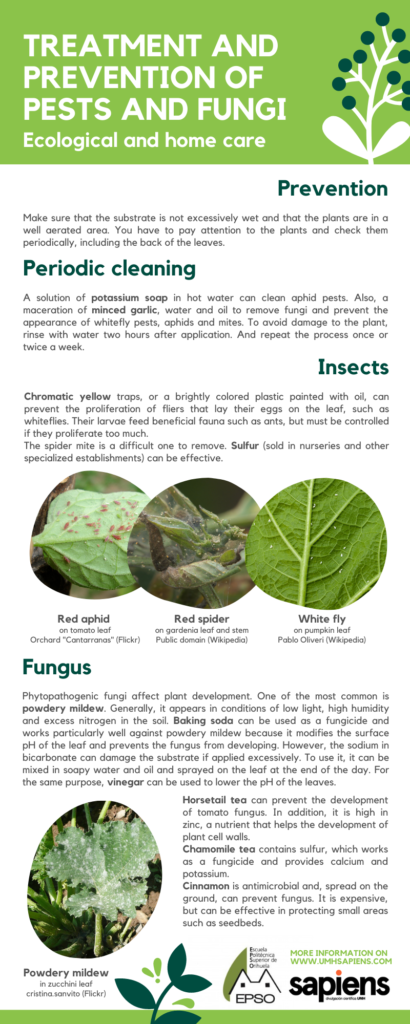
If you decide to follow our advice, we would love to see your organic garden regardless of the phase in which it is. You can send your photos to our social media: Facebook, Instagram or Twitter.
With the collaboration of Fundación Española para la Ciencia y la Tecnología-Ministerio de Ciencia e Innovación.

Did you like these activities? You have many more available, for young and old, in the special ‘Science in your living room’


La “Mednight” nace como fruto de la colaboración de un consorcio de 12 entidades: Universidad Miguel Hernández de Elche, Universidad de Alicante, Universitat de València, Universitat Politècnica de València, Universitat Jaume I, Universidad de Murcia, Universidad Politécnica de Cartagena, Fundación Fisabio, Fundación Séneca – Agencia de Ciencia y Tecnología de la Región de Murcia, INCLIVA y el Consejo Superior de Investigaciones Científicas, bajo la coordinación de El Caleidoscopio y con el patrocinio de la Generalitat Valenciana a través de Fundación de la C.V. para el Fomento de Estudios Superiores (FFES), la Casa Mediterráneo, Las Naves y Distrito Digital de la Comunitat Valenciana.




